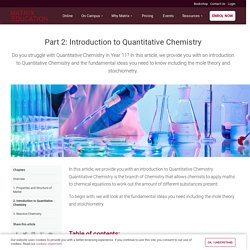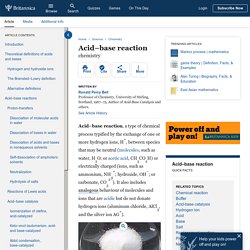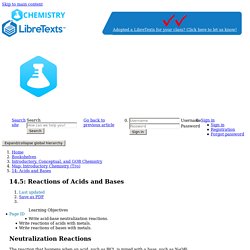

What Is Chemistry? The Science of Substances and Interactions. You might think of chemistry only in the context of lab tests, food additives or dangerous substances, but the field of chemistry involves everything around us.

"Everything you hear, see, smell, taste, and touch involves chemistry and chemicals (matter)," according to the American Chemical Society (ACS), a non-profit science organization for the advancement of chemistry, chartered by the U.S. Congress. "And hearing, seeing, tasting, and touching all involve intricate series of chemical reactions and interactions in your body. " So, even if you don't work as a chemist, you're doing chemistry, or something that involves chemistry, with pretty much everything you do.
In everyday life, you do chemistry when you cook, when you use cleaning detergents to wipe off your counter, when you take medicine or when you dilute concentrated juice so that the taste isn't as intense. Related: Whoa! Chemistry basics Related: How are elements grouped in the periodic table? Chemistry is a physical science Law Law. Chemistry Dictionary, Terms & Definitions - Chemistry-Dictionary.com. Ptable - Periodic Table. Introduction to Quantitative Chemistry. In this article, we provide you with an introduction to Quantitative Chemistry.

Quantitative Chemistry is the branch of Chemistry that allows chemists to apply maths to chemical equations to work out the amount of different substances present. To begin with, we will look at the fundamental ideas you need including the mole theory and stoichiometry. Table of contents: Chemical Reactions and StoichiometryPractical investigationsStoichiometry and the Law of Conservation of MassThe Mole ConceptConcentration and MolarityGas Laws Chemical Reactions and Stoichiometry Quantitative Chemistry is about calculating the amounts of materials in a substance or the quantity of something that could be made from a particular material.
Practical investigations are a means of you learning how to learn and develop these skills. Practical investigations. Quantitative chemical analysis. The Ultimate Guide to Year 11 Chemistry Module 3: Reactive Chemistry. How should you react to Year 11 Chemistry Module 3: Reactive Chemistry?

Just like the periodic table itself, there’s a variety of possible ways to react! To the untrained eye, the periodic table just looks like an inconveniently-shaped table… and maybe sometimes the instructions telling you how to build it are as mysterious as IKEA’s. To the eye in-training, this thing (the Periodic Table) is the centre-of-operations at the construction site of your chemical understanding. It’s the solid foundation that all your future chemistry mastery is going to spring upwards out of.
The periodic table is the centre of Chemistry as a subject and in particular, the Reactive Chemistry module. By completing Year 11 Chemistry Module 1 and 2, you should now understand as much as possible about the individual building blocks the Universe is built out of. And now it’s time for the next phase in the revised Chemistry syllabus – to start throwing these things together and see what they do! Beginner's Guide to Year 11 Chemistry. In this article, we introduce reactive chemistry – how chemical reactions will take place.

You’ve already seen chemical reactions in the previous module, but this information will help you to predict what chemical reaction will occur. Definition, Examples, Formulas, & Facts. Acid–base reaction, a type of chemical process typified by the exchange of one or more hydrogen ions, H+, between species that may be neutral (molecules, such as water, H2O; or acetic acid, CH3CO2H) or electrically charged (ions, such as ammonium, NH4+; hydroxide, OH−; or carbonate, CO32−).

It also includes analogous behaviour of molecules and ions that are acidic but do not donate hydrogen ions (aluminum chloride, AlCl3, and the silver ion AG+). Top Questions What are acids and bases? Acids are substances that contain one or more hydrogen atoms that, in solution, are released as positively charged hydrogen ions. An acid in a water solution tastes sour, changes the colour of blue litmus paper to red, reacts with some metals (e.g., iron) to liberate hydrogen, reacts with bases to form salts, and promotes certain chemical reactions (acid catalysis). How are acids and bases measured? Acid-base reaction (HCl + NaOH)
14.5: Reactions of Acids and Bases. Learning Objectives Write acid-base neutralization reactions.

Write reactions of acids with metals. Write reactions of bases with metals. Neutralization Reactions The reaction that happens when an acid, such as , is mixed with a base, such as : When an acid and a base are combined, water and a salt are the products. After removing the spectator ions, we get the net ionic equation: When a strong acid and a strong base are combined in the proper amounts—when equals ]\)—a neutral solution results in which pH = 7.
Salt solutions do not always have a pH of 7, however. Example : Propionic Acid + Calcium Hydroxide Calcium propionate is used to inhibit the growth of molds in foods, tobacco, and some medicines. Solution Exercise Write a balanced chemical equation for the reaction of solid barium hydroxide with dilute acetic acid. Answer Acids and Bases React with Metals Acids react with most metals to form a salt and hydrogen gas. Contributions & Attributions Peggy Lawson (Oxbow Prairie Heights School). Organic Chemistry Portal. All Organic chemistry articles.